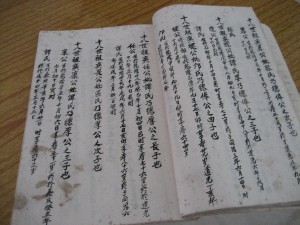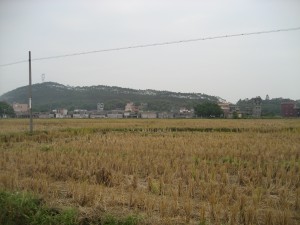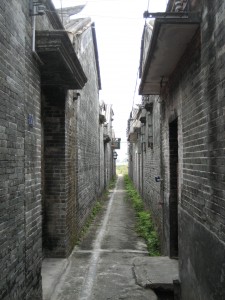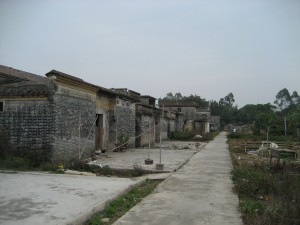Video, transcript and slides of a talk on ‘Uncovering the stories of Chinese Australian families’, presented at Libraries Tasmania in Hobart on 8 August 2023
When I began researching the history of Chinese Australian families more than two decades ago, the sources I first came across, including accounts by politicians and journalists, focused on an absence of ‘real’ family life among the colonial Chinese population.
Despite this, other sources provided tantalising hints at the presence of a small number of Chinese women as well as a significant number of families made up of a Chinese father and white mother.
In this talk, I share how I, alongside a growing number of family historians, have gone about uncovering the stories of Chinese Australian families and consider how their transnational lives are an important part of the history of connection between China and Australia.
You can watch the video, or read the text of my presentation below.
Video
Video also available on the Libraries Tasmania YouTube channel, and audio only is available on the Libraries Tasmania SoundCloud.
Transcript and slides
Over the past couple of decades, a number of Australian and New Zealand writers have produced works of historical fiction featuring romances between white women and Chinese men.
One of the best known is the ongoing and somewhat illicit liaison between Kerry Greenwood’s lady detective, Phryne Fisher, and Lin Chung, the Cambridge-educated son of an elite Victorian Chinese family of silk merchants, whose progenitor had first arrived in Australia with the gold rushes.

Lin Chung first appears in the seventh book in the Phryne Fisher series, Ruddy Gore, published in 1995, and while he is an intermittent character across the two dozen novels, he – along with a string of other lovers – is central to the portrayal of Phryne’s liberal attitude towards life and obvious pleasure in flaunting the social mores of respectable 1920s Melbourne.
A few other examples are worth mentioning, too.

There’s Neridah Newton’s The Lambing Flat, published in 2003, which won the Queensland Premier’s Literary Award for an Emerging Author in 2002. It follows the intertwined lives of Ella, born and bred on a Queensland cattle station, and Lok, who arrives in Australia as a boy and experiences the violence of the Lambing Flat anti-Chinese riots of 1861, before heading north to Queensland. He finds work on Ella’s father’s property, and the love story progresses from there.
There’s also As the Earth Turns Silver, by New Zealand author Alison Wong, which won the Janet Frame Fiction Award in 2009. Set against the backdrop of racist white working-class Wellington in the early twentieth century, the book tells the ultimately tragic story of a secret love affair between widow and mother of two, Katherine McKechnie, and Wong Chung-yung, a greengrocer.

Then there’s Deborah O’Brien’s Mr Chen’s Emporium, and its sequel The Jade Widow, which are aimed more at the ‘book club’ market. Mr Chen’s Emporium plots a fairly predictable romantic path to the marriage of Amy Duncan and Charles Chen in a small New South Wales goldfields town in the 1870s – and their relationships, once again, ends tragically. While not great literature, Mr Chen’s Emporium is nonetheless pretty spot-on with its history.

As a historian I’ve spent much of my career looking into the lives of white women and Chinese men who formed intimate relationships in the past, women and men like the protagonists in these novels.
This research has been part of my broader interest in the histories of women, children and families of Australasia’s early Chinese communities – and a caveat here, the ‘Chinese Australian families’ I’ll be talking about today are predominantly those made up of a white mother and Chinese father.
So, it interests me very much to see stories of Chinese-European couples being told again through fiction in the twenty-first century, in television as well as the novels I’ve mentioned – some of you might have watched, for example, the 2021 SBS mini-series New Gold Mountain, which touches on the tangled lives of Chinese men and white women on the Victorian goldfields.
I say ‘again’ because more than a century ago, in the 1880s and 1890s, intimate relationships between white women and Chinese men were not an uncommon subject in popular Australian fiction.

Typified by Edward Dyson’s ‘Mr and Mrs Sin Fat’, published in the Bulletin in 1888, or William Lane’s novella ‘White or Yellow? The Race War of 1908AD’, published as a serial in the Boomerang in 1887, late nineteenth-century stories tell a very different tale of interracial relationships, of their dangers on a personal and societal level. Such stories both drew on and fed accounts that appeared in popular newspapers such as the notoriously salacious Truth.
I want to suggest, however, that the telling of these two very different narratives of love and sex across racial boundaries have something very much in common. And that is that their meaning, their power as stories, comes from their acknowledgement of not just the possibility, but the reality, of intimate relationships between white women and Chinese men in Australia and New Zealand in the late nineteenth and early twentieth centuries.

The scare power of stories like those published in the Bulletin and the Boomerang came from an understanding that all around the Australasian colonies white women and Chinese men were getting together. Yes, in opium dens and brothels, but also through contacts at church, at the store, across the threshold of the home, in the neighbourhood. These stories presented a threatening future of racial mixing in Australia that was made more real by the presence of mixed-race couples and their mixed-race children in colonial communities – they were simply there.
Estimates carefully calculated by historians like myself put the number of legal marriages between Chinese men and white women in the Australasian colonies in the nineteenth century in the thousands – but of course there were many other relationships not formalised through marriage and many children born out of wedlock.

While official statistics are unreliable in giving the true number of children born to white mothers and Chinese fathers, they do give some indication of their significance in the Chinese Australian population overall.
Here, for example, is a breakdown of the birthplaces of Chinese people in New South Wales in 1901, where you can see (in blue) that a total of 1,223 were Australian born (in New South Wales and other Australian states), and of them 1,028 – about 9% of the total Chinese population – were so-called ‘half-castes’, which in this case meant people of mixed white and Chinese heritage.

What about Tasmania, I hear you say!
Looking at 1901 again, the Chinese population of Tasmania was 609, of whom 103 – or about 17% – were of mixed Chinese-European parentage.
Over the course of the twentieth century, though, the obvious presence of Chinese-European couples and their families faded for various reasons – within families themselves, in popular memory, and in historical accounts. The perception that lingered was that interracial relationships between white women and Chinese men were bound up with prostitution, alcoholism, opium addiction and so on, and that only ‘a few illiterate Irish girls’ were desperate enough to marry themselves to Chinese men.
What was forgotten were the thousands of Chinese-European couples who, mostly unremarkably, met, formed relationships of different kinds (for shorter or longer periods of time), had children, and raised them together or apart.

Families like that of Hannah Maria Mason, who was born in Launceston in 1844, and her Amoy-born husband, William Edward Oram Chi.
Hannah and William married in the Wesleyan Parsonage at Newtown, Sydney, in 1865, four years after William was baptised as a Christian. After the stillbirth of their first child in 1866, Hannah and William went on to have another son and five daughters. William was naturalised as a British subject in 1868 and the family became part of the community of Scone, in central New South Wales, where they made their home.
It has only really been in this new century, over the past 25 years or so, that early Chinese-European families like the Chis have been remembered and recognised on a broader scale. The historical novels I mentioned are one manifestation of this.
Alongside the work of academic historians like myself, it has largely been the growing interest in family history that has shifted our understanding, as family researchers have pieced together often-hidden parts of their own histories.
These same family historians, and local and community historians, are increasingly visible online, creating their own blogs and websites, making family trees in Ancestry.com, and participating in family history forums and Facebook groups. They are publishing memoirs and family histories, they are presenting at history conferences, and they are collaborating with researchers in universities and GLAM organisations, particularly museums.

If you’re an avid viewer, you might also have noticed stories of Chinese-European families pop up in the television series Who Do You Think You Are?
In 2018, there was the story of actor John Jarratt’s 2 x great grandparents, Martha Hamilton and Ah Yot, who lived at a little place called Jembaicumbene on the Braidwood goldfields in New South Wales, and more recently, in 2021, there was the story of musician Jeff Fatt’s 2 x great grandparents, Elizabeth Wright and Lee Young, who lived at Ararat and Ballarat on the Victorian goldfields.
When I first began researching Chinese-European couples back in the late 1990s, the most common question I was asked about my work was ‘why?’ In particular, ‘why did these white women choose Chinese partners? – the implication being a slightly different question, I think, and that was ‘Wasn’t there anyone better (i.e. white) for them to marry?’
The decisions made by mixed-race couples in their choice of partner can seem extraordinary for their time, but they may in fact have been very simple ones to make, based around love, sexual attraction, the desire for companionship, or due to circumstance, convenience, or economics.
Despite some failings in historical accuracy, one of the things I like most about seeing Chinese-European relationships portrayed in contemporary fiction is the way that fiction can present historical possibilities that, it seems, are still often hard for many of us to imagine.
Once you start looking for it, though, evidence of Chinese-European couples and families is abundant and, with the digitisation of more and more historical materials, that evidence is increasingly easy to find and access. The historical newspapers available through Trove, from the National Library, are a particularly rich source for Chinese Australian family history, and one that I didn’t have when I started my research way back when!

Here, for instance, is a graph of references to the term ‘half-caste Chinese’ in the digitised newspapers in Trove for the period from 1860 to 1920, created using a nifty app called QueryPic, created by digital historian Tim Sherratt. The articles that come up through this search range from invectives in major city newspapers about opium and smallpox and ‘the Chinese Question’, to reports in small country newspapers on all manner of moments in the everyday lives of Chinese Australian families and individuals.

As a historian, I’m lucky that race was mentioned in such articles, as it marks these articles as immediately of interest to me. But, of course, personal names can also be traced through time in the newspapers, in a way that was near impossible before.
Trove, and its New Zealand counterpart Papers Past, give us the ability to easily uncover small stories of ordinary lives and this helps break through a barrier in thinking about the prevalence and place of Chinese-European couples and families in colonial Australasia.

Our understanding of the history of Chinese Australian families has come a long way in the past twenty-five years.
When I started my research in 1998, the available historical literature said little that was of help to me about Chinese Australian family life, particularly in understanding these families within the context of Chinese migration.
Most histories overlooked the presence of migrant Chinese women and their daughters in colonial and post-Federation Australasia, and those few that discussed Chinese-European families in any detail framed their lives as stories of ‘pioneers’ or of ‘assimilation – unusual exceptions to the dominant story of the sojourning gold-seeker living a lonely life, working to make his fortune and return home to China.
Many Chinese Australian family histories are easily slotted into these sorts of narratives, and it can make sense to tell them in this way – particularly for descendants, community activists, and historians of many kinds struggling to assert Chinese people into a national story that still remains one predominantly about white people. They are keen to stress how people of Chinese heritage, whether migrant or Australian born, have contributed to the building of this nation particularly through agriculture, mining, and business.
However, when I started looking closely into the lives of Chinese-European couples and their children, the pioneer or assimilationist frameworks did not fit so well with evidence I found about the mixing of language and cultural traditions within the home, and about the ongoing connections mixed families fostered and maintained with local Chinese communities and with China itself.
For example, the Australian-born mixed-race daughters of Chinese settlers commonly married migrant Chinese men, sometimes men as old as their own fathers, creating networks of kinship ties and often drawing young Australian-born women towards their Chinese, rather than European, heritage.
This picture, for example, shows Emma Lee Young with her husband, the Rev. Joseph Tear Tack, and four of their children – Elizabeth, Joseph, Laura and Josiah, who born between 1886 and 1892. As featured in Who Do You Think You Are?, Emma was Purple Wiggle Jeff Fatt’s great-grandmother.
She was born in Ararat, Victoria, in 1865, and at the age of 20 married China-born Joseph Tear Tack, who was about 17 years her senior. With Joseph’s church work, the family moved from Ararat in Victoria to the Inverell district in New South Wales, and then to Darwin and eventually to Cairns.
Numbers of Chinese-European children were taken or sent to China to help them to ‘become Chinese’ by receiving a Chinese education and/or being raised within their extended Chinese families.
White wives, too, went to China, where some encountered for the first time the unhappy reality that they were not their husband’s only wife – for according to Chinese custom, men were able to take multiple wives and concubines. Other white wives said goodbye to children and husbands who left for China and never returned.

These practices didn’t fit neatly with the idea that Chinese men who formed relationships with white women, who fathered mixed-race children, were simply assimilating, turning their backs on their own ancestry and heritage and abandoning an identity as Chinese for themselves and their children – even when it might have seemed on the surface that that’s what they were doing.
Quong Tart, the well-known Sydney tea merchant, shown here with his wife Margaret and their three oldest children in Hong Kong in 1894, is an interesting example of this.
We know Quong Tart best as the dapper businessman and philanthropist, anti-opium campaigner and friend to Sydney’s elite (and coincidentally, my great-grandfather, Harry Bagnall), the beloved husband of Lancashire-born Margaret (née Scarlett) and father to a brood of handsome children who were educated at some of Sydney’s finest private schools.
Yet Quong Tart’s business interests were reliant on ongoing contacts with Hong Kong and China, and it seems he remained close to his family, returning to China three times, including in 1894 to introduce his young family to his elderly mother. Research by Chinese historian, Mei Weiqiang, and information gathered within the family, also suggests that Quong Tart was married by proxy, in absentia, to a Chinese woman and that one, perhaps, two sons were adopted to carry on his name in his hometown in Toishan.
How to reconcile all this in a man known as the ultimate ‘assimilated’ Chinese?

An article by US historian Adam McKeown, published in 1999 (nearly 25 years ago now!), on ‘Transnational Chinese Families and Chinese Exclusion‘, suggested to me that there was an alternative way of viewing these relationships, an alternative explanation for why Chinese men ‘outmarried’ (that is, partnered with non-Chinese women), and a real way of understanding these families within the context of Chinese migration.
McKeown was among a number of scholars who have outlined the family strategies used by Cantonese in the sending districts of the Pearl River Delta in Guangdong province in southern China, from where most nineteenth-century Chinese migration took place.

Central to the Cantonese family was the patriline, the ongoing line of descent from father to son, father to son.
Cantonese families in the sending districts of the Pearl River Delta undertook economic strategies to ensure their survival and prosperity – such as establishing sons in different occupations or sending them to different overseas locations, such as Australia, New Zealand, the United States, and Canada. They also developed strategies to ensure the continuation of the family line when more usual patterns of family formation were not possible due to the often long absences of men overseas.
Most common was the ‘split’ family, where a man lived overseas for shorter or longer periods, while his wife remained at home in his ancestral village, often living with her in-laws or other members of her husband’s family. When a man had left unmarried and was not easily able to return, he could be married by proxy in absentia to a woman who then took up residence in her parents-in-law’s home. Sons could be adopted to ensure the patriline continued, even if husband and wife never met due to his continued residence overseas.
Non-Chinese women were drawn into this when they formed relationships with Chinese men – and it was not uncommon for Chinese men to already have a wife, and sometimes children, at home in China when they formed relationships overseas.
Chinese families could be opposed to men taking foreign wives, out of fear that his interests and energies would be redirected away from the ancestral home and his filial obligations there. (In the early decades of the twentieth century, there were also warnings by Chinese community leaders overseas against relationships with non-Chinese women, fearing that patriotic sentiments towards a new China might dissipate).
But children born to non-Chinese women in places like Australia and New Zealand, Hawaii, the United States, Canada, Mexico, Jamaica and Peru still counted as ‘Chinese’ and as part of their Chinese families. Their paternity (biological or adoptive), not their maternity, mattered. The evidence for this is in the number of children of mixed race who went to China, for a period of education or more permanently, a practice that was happening in the Australian colonies from early as the late 1850s.

The National Archives of Australia holds thousands of documents that trace the journeys of young Australians of Chinese and part-Chinese heritage to China and back over the early decades of the twentieth century – after the introduction of the federal Immigration Restriction Act in 1901. Included among those who went to China were a small number of children of mixed Chinese-Aboriginal heritage, as well as a few white stepchildren of Chinese men.
You might, for instance, have heard of Tasmanian Senator Thomas Bakhap – the son of Margaret Hogan and stepson of Gee Bak Hap of Lottah in north-eastern Tasmania. There is debate about whether Thomas Bakhap had Chinese heritage or not, but he became fluent in Cantonese and, according to Adrienne Petty, ‘had spent several years in China, some as a young child and later in his early teens’ (‘Deconstructing the Chinese Sojourner: Case Studies of Early Chinese Migrants to Tasmania’, PhD thesis, UTAS, 2009, p. 124).

Before I conclude, I’d like to share one more family story, that of the Gan family, pictured here in Melbourne in 1917. There is Edward Chung Ah Gan, usually known as ‘Teddy Ah Gan’, who was naturalised as a British subject in Tasmania in 1891, his Victorian-born wife, Annie (née Harris), and their four children – Dorothy, George, Ruby Elizabeth and Frederick.
The family left Australia for Hong Kong in 1917, where Teddy found work at the Hong Kong and Whampoa Dock Company, and Annie was busy with her growing family – she gave birth to three more children in Hong Kong. In 1925 and again in 1933, the family attempted to return to Australia, but this request was denied due to Teddy’s extended absence from the Commonwealth, and there is nothing on file to indicate that they ever did come home.
Placing the history of Chinese-European families within a transnational framework, like that suggested by McKeown’s ‘transnational overseas Chinese family’, allows us to see the parts of the story that took place beyond Australian shores.
Chinese migration to Australia wasn’t a simple one-way trip – economic, cultural and legal factors meant that Australian Chinese were highly mobile, travelling back and forth between Australia and China, and between colonies and states, too. The formation of families followed a similar path, and limiting our definition of ‘family life’ to the ‘geographically localized nuclear family’ (to use McKeown’s phrase, p. 100) ignores a range of experiences and choices made in the process of migration, sojourning and settlement.
So, to conclude let’s go back to those historical novels, where we can also see aspects of the transnational overseas Chinese family:
- Lady detective Phryne Fisher sees her lover Lin Chung married to a young Chinese woman, Camellia, in an arrangement that benefits both Chinese families, if not themselves.
- In As the Earth Turns Silver, Katherine McKechnie’s Chinese lover has a wife and child in China, while his brother works for years to be able to bring his wife to live in New Zealand too.
- In The Lambing Flat, Ella has to confront Lok’s yearning for his homeland and his ultimate decision to return home. He asks her to go too, and some of my favourite passages in the book describe Ella’s feelings as she contemplates whether she could leave her home and go with him. In the end, though, she doesn’t.
What these imagined life stories suggest, and other real life histories demonstrate, is that there is not just one neat framework into which we can place the history of Chinese-European families in Australasia, and beyond that the history of Chinese Australian families. This history is messy and complex and sometimes hard to untangle – but for me, this messiness and complexity is also what makes it so fascinating.


























